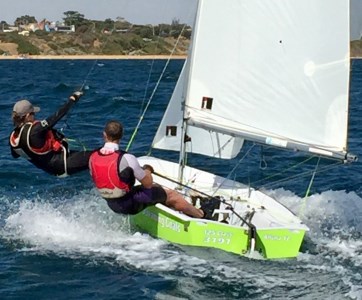|
|
125 Discussion Forum
Please note: This forum is read by a wide group of 125 sailors.
This is not the place for personal attacks or inappropriate comments on anyones race, sex, age or sailing abilities.
Return to the Forum List  Spinnaker rig Spinnaker rig | I have an old wooden boat (591) that I mess about in with my sons. They are keen to use the spinnaker now and we have been trying to make sense of the rigging that we've got.
I do not have another 125 nearby to compare with- I am in the wilds of tasmania.
There are combined hooks and cleats on the gunwales forward of the chainplates. I imagine that they must bring the tack and/ or brace down to avoid the trapezing crew. There are small blocks below each gunwale well astern, near the transom. There is a cam cleat under the port thwart and a jam cleat stbd. There is a chute and sock.
I would love a photo or drawing of a similar setup. Can anyone help?
| |
|  Re: Spinnaker rig Re: Spinnaker rig | When using a chute the halyard makes a continuous vertical loop with the spinnaker in the middle. Tie the halyard to the head of the spinnaker with a bowline. The halyard goes over a pulley on the front of the mast above the jib attachment point. Then down the mast and usually back to the skipper. This shares the workload. There may be an aluminium tube through the deck and exiting the main bulkhead near the floor level. Alternatively there may be a turning block usually on the port side of the mast low down with another on the port side of the centrecase.
Next there may be a turning block or steel lined fairlead low down on the back port side of the centrecase. This location enables the skipper the use his legs as well as arms in hoisting the spinnaker. It is held aloft with a cleat on the top of the back face of the centre case. The pull is vertically up. The rest of the halyard then goes through a steel lined fairlead under the thwart (port side) and through the chute sock tying off to a strap or cringle in the centre of the spinnaker. This is used to retrieve the spinnaker into the chute when not in use.
The sheets (ropes) to control the spinnaker again form a continuous horizontal loop. Tie one end to the spinnaker cringle with the retrieval line on the inside. Going outside of everything pass the sheet through the turning blocks in the side near the transom. Then go forward to a turning block usually on the seat tops near the thwart. There should be a cam cleat in this area. Go across the boat to the turning block on the other side and out via the turning block near the transom/side panel. Tie onto the other corner of the spinnaker.
When flying the spinnaker, the spinnaker pole is used on the windward side to hold the sail out away from the jib. Just clip onto the windward sheet and push it out. When not in use it is stored alongside the boom. A topping lift prevents it being dropped into the water – this would be the cleat under the starboard side of the thwart. Look for a small pulley on the mast half way between the boom and jib hounds and a means for it to go back to the cleat. On the spinnaker pole there will be a means for this topping lift to slide along to the centre and be held by a ramp, pair of bolts etc. The topping lift rope is usually a loop around the pole. If it is permanently attached whilst sailing, it is more difficult for the crew to throw expensive spinnaker poles over the side. There may also be a rope attached to the base of the mast to limit how high the pole can sky.
When sailing with a spinnaker with the wind on the beam, there is extreme pressure on the sheet attached to the pole. Minimise the length of rope stretch by using the hooks and cleats forward of the chainplates on the windward side only. The downward pressure is essential to stop a tendency for the pole to sky up the mast. The leeward side must be free to fly away from the mainsail, opening a slot to enable the spinnaker to exhaust wind.
| |
|
Return to the Forum List Add a message to this discussion
Measurer's Forum
Committee's Forum
|
|


